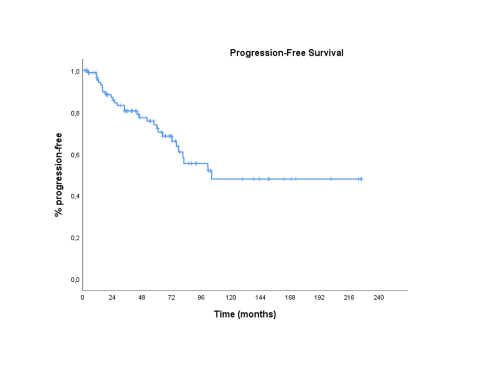
Contributions
Abstract: PB1577
Type: Publication Only
Session title: Indolent and mantle-cell non-Hodgkin lymphoma - Clinical
Background
Early stage follicular lymphoma (FL) is considered a potentially curable disease. Involved-field radiotherapy (IFRT) ± immunotherapy/immunochemotherapy is the standard treatment approach by most centers, although few data exist from randomized clinical trials. Long-term follow-up is needed to rule out very late relapses.
Aims
The aim of the present study was to assess the long-term outcome and identify prognostic factors and best treatment approaches in a series of patients with localized FL treated in a single unit.
Methods
This is a retrospective analysis on 106 consecutive localized FL patients diagnosed between 2000 and 2020 from a single center. The mean follow-up of the patients is 82.3 months. The following parameters were evaluated as possible prognostic factors: stage, age, gender, histological grade, ki-67, hemoglobin, LDH, monocyte count, lymphocyte count, bulk (>/= 7cm), FLIPI score and type of treatment.
Results
Median patients’ age was 56,4 years and 67 (63%) were females. 72 (68%) cases were histological grade 1/2 and the remaining 34 (32%) were grade 3A. 71 patients (67%) were Stage 1 and 35 (33%) Stage 2; 94 patients (88,7%) had performance status 0. 14 patients (13.3%) has an elevated LDH and 19 (18.1%) had bulky disease. IFRT was delivered in 50 (47.6%) patients and anti CD20+ antibody (Ab) in 74 (70.5%). More specifically 21% received IFRT only, 29% received IFRT+Rituximab, 45% received anti CD20+ Ab+chemotherapy and 5% received chemotherapy only. Complete response was achieved in 92,3 %. 31 patients progressed (among these 35% within 24 months from initiation of treatment; 93% experienced limited stage disease at first relapse). Of note, there was a median progression free survival (PFS) of 104,39 months and a 5-and 10-year PFS of 74% and 48% respectively. Most importantly, a plateau in the PFS curve was observed at 8.7 years. At last follow up, 10 patients (9,4%) had expired but only 5 (4.7%) died due to lymphoma, resulting in a 10-year overall survival (OS) of 88% and a 10-year disease specific survival (DSS) of 95%. There was no significant difference in PFS, OS and DSS according to treatment. Bulky disease was the only poor prognostic factor for PFS, although with marginal significance, whereas stage, bulk and FLIPI score were prognostic for DSS.

Conclusion
With long follow-up, early stage FL is a curable disease for the majority of patients with no relapses observed after 8.7 years, irrespectively of treatment. Bulky disease seems to be the most important prognostic parameter.
Keyword(s): Follicular lymphoma, Indolent non-Hodgkin's lymphoma, Long-term follow-up, Prognostic factor
Abstract: PB1577
Type: Publication Only
Session title: Indolent and mantle-cell non-Hodgkin lymphoma - Clinical
Background
Early stage follicular lymphoma (FL) is considered a potentially curable disease. Involved-field radiotherapy (IFRT) ± immunotherapy/immunochemotherapy is the standard treatment approach by most centers, although few data exist from randomized clinical trials. Long-term follow-up is needed to rule out very late relapses.
Aims
The aim of the present study was to assess the long-term outcome and identify prognostic factors and best treatment approaches in a series of patients with localized FL treated in a single unit.
Methods
This is a retrospective analysis on 106 consecutive localized FL patients diagnosed between 2000 and 2020 from a single center. The mean follow-up of the patients is 82.3 months. The following parameters were evaluated as possible prognostic factors: stage, age, gender, histological grade, ki-67, hemoglobin, LDH, monocyte count, lymphocyte count, bulk (>/= 7cm), FLIPI score and type of treatment.
Results
Median patients’ age was 56,4 years and 67 (63%) were females. 72 (68%) cases were histological grade 1/2 and the remaining 34 (32%) were grade 3A. 71 patients (67%) were Stage 1 and 35 (33%) Stage 2; 94 patients (88,7%) had performance status 0. 14 patients (13.3%) has an elevated LDH and 19 (18.1%) had bulky disease. IFRT was delivered in 50 (47.6%) patients and anti CD20+ antibody (Ab) in 74 (70.5%). More specifically 21% received IFRT only, 29% received IFRT+Rituximab, 45% received anti CD20+ Ab+chemotherapy and 5% received chemotherapy only. Complete response was achieved in 92,3 %. 31 patients progressed (among these 35% within 24 months from initiation of treatment; 93% experienced limited stage disease at first relapse). Of note, there was a median progression free survival (PFS) of 104,39 months and a 5-and 10-year PFS of 74% and 48% respectively. Most importantly, a plateau in the PFS curve was observed at 8.7 years. At last follow up, 10 patients (9,4%) had expired but only 5 (4.7%) died due to lymphoma, resulting in a 10-year overall survival (OS) of 88% and a 10-year disease specific survival (DSS) of 95%. There was no significant difference in PFS, OS and DSS according to treatment. Bulky disease was the only poor prognostic factor for PFS, although with marginal significance, whereas stage, bulk and FLIPI score were prognostic for DSS.

Conclusion
With long follow-up, early stage FL is a curable disease for the majority of patients with no relapses observed after 8.7 years, irrespectively of treatment. Bulky disease seems to be the most important prognostic parameter.
Keyword(s): Follicular lymphoma, Indolent non-Hodgkin's lymphoma, Long-term follow-up, Prognostic factor


